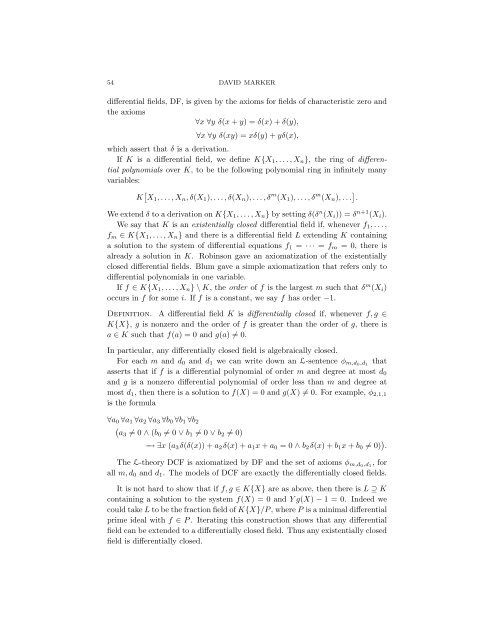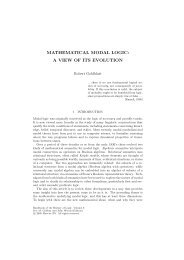Model Theory of Differential Fields
Model Theory of Differential Fields
Model Theory of Differential Fields
You also want an ePaper? Increase the reach of your titles
YUMPU automatically turns print PDFs into web optimized ePapers that Google loves.
54 DAVID MARKERdifferential fields, DF, is given by the axioms for fields <strong>of</strong> characteristic zero andthe axioms∀x ∀y δ(x + y) = δ(x) + δ(y),∀x ∀y δ(xy) = xδ(y) + yδ(x),which assert that δ is a derivation.If K is a differential field, we define K{X 1 , . . . , X n }, the ring <strong>of</strong> differentialpolynomials over K, to be the following polynomial ring in infinitely manyvariables:K [ X 1 , . . . , X n , δ(X 1 ), . . . , δ(X n ), . . . , δ m (X 1 ), . . . , δ m (X n ), . . . ] .We extend δ to a derivation on K{X 1 , . . . , X n } by setting δ(δ n (X i )) = δ n+1 (X i ).We say that K is an existentially closed differential field if, whenever f 1 , . . . ,f m ∈ K{X 1 , . . . , X n } and there is a differential field L extending K containinga solution to the system <strong>of</strong> differential equations f 1 = · · · = f m = 0, there isalready a solution in K. Robinson gave an axiomatization <strong>of</strong> the existentiallyclosed differential fields. Blum gave a simple axiomatization that refers only todifferential polynomials in one variable.If f ∈ K{X 1 , . . . , X n } \ K, the order <strong>of</strong> f is the largest m such that δ m (X i )occurs in f for some i. If f is a constant, we say f has order −1.Definition. A differential field K is differentially closed if, whenever f, g ∈K{X}, g is nonzero and the order <strong>of</strong> f is greater than the order <strong>of</strong> g, there isa ∈ K such that f(a) = 0 and g(a) ≠ 0.In particular, any differentially closed field is algebraically closed.For each m and d 0 and d 1 we can write down an L-sentence φ m,d0,d 1thatasserts that if f is a differential polynomial <strong>of</strong> order m and degree at most d 0and g is a nonzero differential polynomial <strong>of</strong> order less than m and degree atmost d 1 , then there is a solution to f(X) = 0 and g(X) ≠ 0. For example, φ 2,1,1is the formula∀a 0 ∀a 1 ∀a 2 ∀a 3 ∀b 0 ∀b 1 ∀b 2(a3 ≠ 0 ∧ (b 0 ≠ 0 ∨ b 1 ≠ 0 ∨ b 2 ≠ 0)−→ ∃x (a 3 δ(δ(x)) + a 2 δ(x) + a 1 x + a 0 = 0 ∧ b 2 δ(x) + b 1 x + b 0 ≠ 0) ) .The L-theory DCF is axiomatized by DF and the set <strong>of</strong> axioms φ m,d0,d 1, forall m, d 0 and d 1 . The models <strong>of</strong> DCF are exactly the differentially closed fields.It is not hard to show that if f, g ∈ K{X} are as above, then there is L ⊇ Kcontaining a solution to the system f(X) = 0 and Y g(X) − 1 = 0. Indeed wecould take L to be the fraction field <strong>of</strong> K{X}/P , where P is a minimal differentialprime ideal with f ∈ P . Iterating this construction shows that any differentialfield can be extended to a differentially closed field. Thus any existentially closedfield is differentially closed.
















